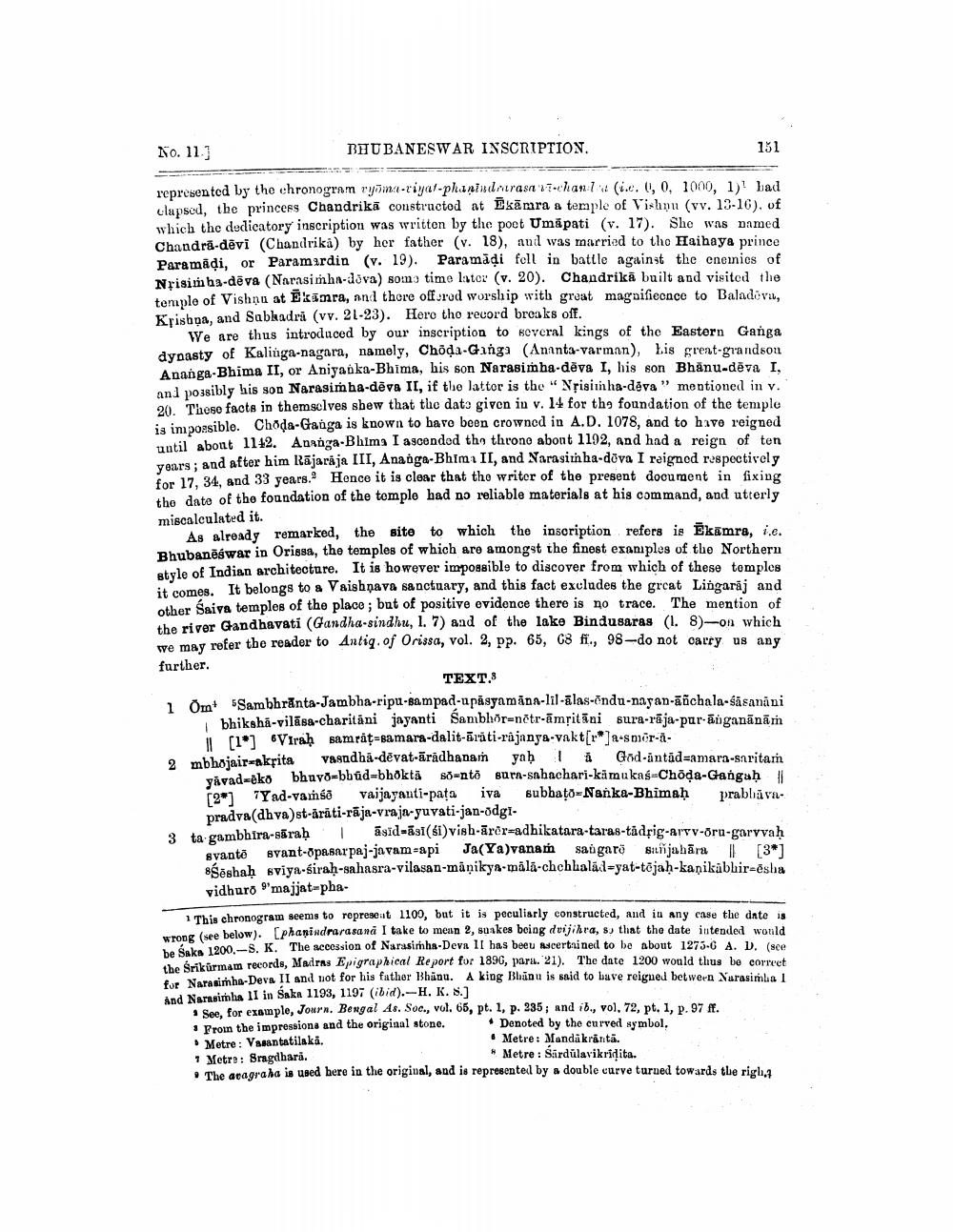________________
BHUBANESWAR INSCRIPTION.
151
No. 11.3
represented by the chronogram ryoma-riyal-phanindrarasavichana (ie. U, 0, 1000, 1) had elapsed, the princess Chandrika constructed at Ekamra a temple of Vishnu (vv. 13-16), of which the dedicatory inscription was written by the poet Umäpati (v. 17). She was named Chandra-devi (Chandrika) by her father (v. 18), and was married to the Haihaya prince. Paramaḍi, or Paramardin (v. 19). Paramaḍi fell in battle against the enemies of Nrisimha-deva (Narasimha-dova) some time later (v. 20). Chandrika built and visited the temple of Vishnu at Examra, and there offered worship with great magnificence to Baladeva, Krishna, and Sabhadra (vv. 21-23). Here the record breaks off.
We are thus introduced by our inscription to several kings of the Eastern Ganga dynasty of Kalinga-nagara, namely, Choda-Ganga (Ananta-varman), his great-grandsou Ananga-Bhima II, or Aniyanka-Bhima, his son Narasimha-deva I, his son Bhanu-dēva I, and possibly his son Narasimha-deva II, if the lattor is the "Nrisinha-deva" mentioned in v. 20. These facts in themselves shew that the date given in v. 14 for the foundation of the temple is impossible. Choda-Ganga is known to have been crowned in A.D. 1078, and to have reigned until about 1142. Ananga-Bhima I ascended the throne about 1192, and had a reign of ten years; and after him Rajaraja III, Ananga-Bhima II, and Narasimha-dova I reigned respectively for 17, 34, and 33 years. Hence it is clear that the writer of the present document in fixing the date of the foundation of the temple had no reliable materials at his command, and utterly miscalculated it.
As already remarked, the site to which the inscription refers is Ekamra, i.e. Bhubaneswar in Orissa, the temples of which are amongst the finest examples of the Northern style of Indian architecture. It is however impossible to discover from which of these temples it comes. It belongs to a Vaishnava sanctuary, and this fact excludes the great Lingaraj and other Saiva temples of the place; but of positive evidence there is no trace. The mention of the river Gandhavati (Gandha-sindhu, 1. 7) and of the lake Bindusaras (1. 8)-on which we may refer the reader to Antiq. of Orissa, vol. 2, pp. 65, C8 fi., 98-do not carry us any
further.
TEXT.3
1 Om Sambhranta-Jambha-ripu-sampad-upasyamana-lil-alas-endu-nayan-añchala-sāsanāni bhiksha-vilasa-charitani jayanti Sambhor-netr-amṛitāni sura-raja-par-ānganānāṁ [1] Viraḥ samraṭ-samara-dalit-arati-rajanya-vakt[r]a-smer-a
2 mbhojair-akrita
vasudha-dēvat-arādhanam yaḥ a God-antad-amara-saritam yavad-eko bhuvo-bbüd-bhökta so-nto sura-sahachari-kamukas-Chōda-Gangaḥ || [2] "Yad-vamso Vaijayanti-pata iva subbato-Nanka-Bhimaḥ prabbavapradva(dhva)st-irâti-ja-vraja-yuvati-jan-edgt
3 ta gambhira-sāraḥ
asid-asi(śi)vish-arer-adhikatara-taras-tādrig-arvv-õru-garvvaḥ
svanto svant-opasarpaj-javam-api Ja(Ya)vanam sangaro sanjahāra || [3*] 8Seshaḥ sviya-sirah-sahasra-vilasan-manikya-mala-chchhalad-yat-tējaḥ-kanikabhir-esha vidhuro 'majjat-pha
Metre: Vasantatilaka.
7 Metre: Sragdhara.
1 This chronogram seems to represent 1100, but it is peculiarly constructed, and in any case the date is wrong (see below). [phanindrarasana I take to mean 2, suakes being dvijihra, s, that the date intended would be Saka 1200.-S. K. The accession of Narasimha-Deva II has beeu ascertained to be about 1275-C A. D. (sce the Śrikurmam records, Madras Epigraphical Report for 1896, para. 21). The date 1200 would thus be correct for Narasimha-Deva II and not for his father Bhanu. A king Bhanu is said to have reigned between Narasimha I and Narasimha II in Saka 1193, 1197 (ibid).-H. K. S.]
See, for example, Journ. Bengal As. Soc., vol. 65, pt. 1, p. 235; and ib., vol. 72, pt. 1, p. 97 ff. From the impressions and the original stone.
Denoted by the curved symbol, Metre: Mandakrāntā.
"Metre Sürdülavikridita.
The avagraha is used here in the original, and is represented by a double curve turned towards the righ,




